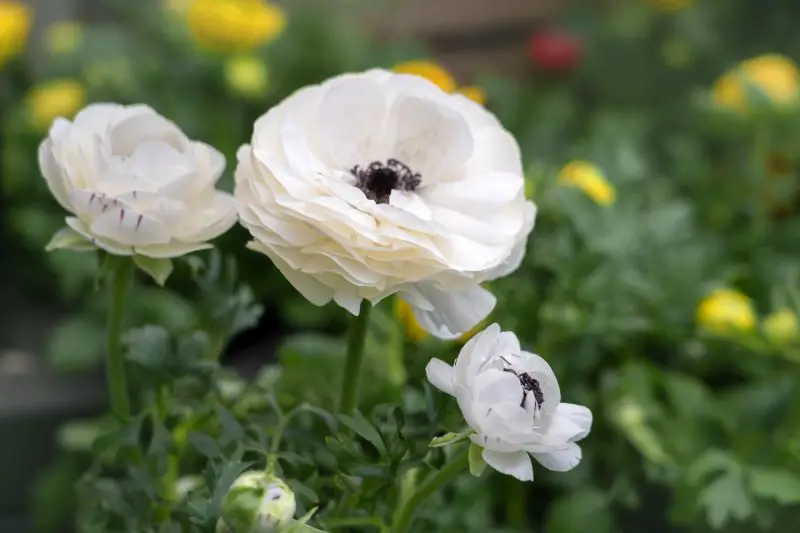Ranunculus, with their vibrant layers of petals and delicate rose-like appearance, bring irresistible charm to spring and early summer gardens. Whether you’re growing them in garden beds or containers, these flowers quickly become a favorite thanks to their wide color range and long vase life. But many gardeners ask: how long do ranunculus bloom, and is there a way to make the display last even longer?
If you’ve fallen in love with ranunculus and want to keep those dreamy blooms around for as long as possible, you’re in the right place. This guide will walk you through the typical blooming period of ranunculus and give you expert care tips to help extend their flowering season, whether you’re growing them in warm zones or cooler climates.
Understanding the Ranunculus Blooming Cycle

When Do Ranunculus Start Blooming?
In mild winter climates such as USDA zones 8–10, ranunculus are usually planted in the fall and begin blooming as early as late February or March. These early plantings take advantage of the cool winter temperatures that ranunculus prefer. In colder zones (zones 4–7), where fall planting isn’t possible due to frost, corms are planted in early spring once the soil is workable. In these regions, blooms typically appear from late April through June. Regardless of region, ranunculus generally need about 90 days from planting to bloom, so timing your planting accordingly is essential for a successful flowering display.
How Long Is the Bloom Period?
Under ideal conditions, the bloom period for ranunculus can last from 4 to 7 weeks, though some gardeners report up to 8 weeks of color with successive planting. Each flower can last around 4 to 10 days on the plant, and new blooms continually emerge throughout the blooming window. By staggering planting dates or choosing different varieties with slightly varied maturity times, you can create a longer, more continuous floral display that stretches deep into the spring season.
What Factors Affect Bloom Duration?
Several key environmental and cultural factors determine how long your ranunculus flowers will bloom. Cool daytime temperatures between 55°F and 70°F (13°C–21°C) are ideal, while hot weather above 75°F (24°C) can cause plants to stop producing new blooms and go dormant. Full sun exposure for at least 6 hours daily ensures strong flower development. Well-draining soil enriched with compost or organic matter supports healthy root systems, while consistent watering—without soggy soil—prevents stress. Regular deadheading, or removing spent flowers, encourages the plant to focus energy on producing new buds rather than seed formation, prolonging the bloom period even further.
Choosing the Right Ranunculus Varieties for Long Blooms
Long-Blooming Ranunculus Types
If your goal is to enjoy ranunculus flowers for as long as possible, selecting the right cultivar makes all the difference. Beyond the well-known ‘Tecolote’ and ‘Bloomingdale’ series, gardeners also praise varieties like ‘Amandine’ for its impressive resilience and extended blooming even in less-than-ideal conditions. The ‘La Belle’ series, originating in Europe, is favored for its long stems, abundant petals, and reliable bloom performance through the spring months.
These premium varieties are not just beautiful—they’re also engineered to provide extended flowering periods when planted in the right conditions. They often begin blooming earlier than standard types and continue producing new buds for several weeks, especially when regularly deadheaded and grown in ideal environments. Many professional florists prefer these long-lasting types not only for their color range but also for their ability to stay fresh longer in vases and arrangements.
Gardeners looking to maximize bloom time should also consider staggering plantings of early-, mid-, and late-season bloomers. This succession planting approach using a mix of long-blooming types ensures a continuous floral display for eight to twelve weeks, especially in climates with mild springs.
Climate Considerations for Variety Selection
When selecting ranunculus varieties for your garden, matching their strengths to your local climate will greatly improve both bloom longevity and plant health. In USDA zones 8–10, where winters are mild and springs can warm quickly, it’s best to choose heat-tolerant varieties that won’t fade early once temperatures rise. The ‘Amandine’ series, for example, is well-suited for southern gardens thanks to its ability to thrive in light spring heat while continuing to produce buds.
In contrast, if you live in a region with colder, longer winters and a shorter growing season—such as USDA zones 4–7—you’ll want to look for cold-hardy ranunculus types that can tolerate late frosts. These varieties can be planted in early spring or even late winter with proper protection and still deliver vibrant blooms in late spring to early summer. Corms should be pre-sprouted indoors or started under cover to help them gain a head start on the season.
Best Time to Plant for Prolonged Blooms
Fall Planting in Mild Climates
If you live in a region with mild winters, such as USDA zones 8 to 10, planting ranunculus in the fall offers a clear advantage. The corms settle into the cool soil and slowly develop strong root systems throughout winter. When spring arrives, they burst into color earlier and continue blooming for longer periods, often extending through late spring. This method is ideal for gardeners seeking abundant and long-lasting blooms with minimal spring maintenance.
Spring Planting in Cooler Zones
For gardeners in colder climates, where winters bring hard frosts and frozen ground, spring is the safer time to plant ranunculus. Once the soil warms and the risk of frost disappears, you can plant the corms and expect a stunning display in late spring or early summer. Though the bloom window is slightly shorter than in fall-planted gardens, you can still enjoy several weeks of continuous color—especially when combined with staggered planting every two weeks to extend the blooming season.
Preparing Soil and Location for Maximum Blooming
Ideal Soil Conditions
Ranunculus prefer a soil that balances moisture retention with excellent drainage. The ideal soil pH falls between 6.0 and 6.5, which is slightly acidic to neutral. Loamy soil enriched with well-aged compost or worm castings provides the ideal nutrient profile to support strong root development and prolific blooming. Avoid heavy clay soils unless amended with sand or perlite, as soggy conditions can cause corms to rot before they sprout. Before planting, perform a simple drainage test by digging a small hole, filling it with water, and ensuring it drains within an hour—if not, improve aeration by mixing in grit or coarse organic material.
Choosing the Right Spot
The success of ranunculus blooms largely depends on choosing a location with optimal light and airflow. Full sun is non-negotiable—at least six hours of unfiltered sunlight per day ensures robust photosynthesis and continuous bud production. In regions with very hot afternoons, light afternoon shade can help prolong blooms, but too much shade will result in weak stems and fewer flowers. Air circulation is equally important: choose a site with gentle breezes to prevent fungal diseases. Avoid low-lying areas where cold air or moisture may settle, as this can delay growth and shorten the blooming window. Raised beds or containers are excellent alternatives in poorly drained or shaded gardens.
Watering and Feeding for Healthy Flowers
Consistent Moisture Without Overwatering
Ranunculus are particularly sensitive to soil moisture levels, especially in the early stages of growth. After planting the corms, water lightly to help them settle without saturating the soil. Once growth begins, increase watering frequency, aiming to keep the soil consistently moist—but never waterlogged. Use a finger test to check the top inch of soil every few days; if it feels dry, it’s time to water. Early morning watering is ideal, as it allows foliage to dry during the day and reduces fungal risk. In hot or windy weather, you may need to water more often, especially if the plants are in containers or raised beds, which dry out faster than ground soil.
For gardeners in rainy climates, consider elevating your ranunculus bed slightly or incorporating sand or perlite into the soil to enhance drainage. Mulching around the plants with straw or shredded bark can help retain moisture and reduce water stress during warm spells.
Fertilizing for Continuous Blooms
Fertilizing at the right time and with the right nutrients is key to getting the best flower display from ranunculus. Begin by incorporating a well-balanced organic fertilizer into the soil before planting, such as one with an N-P-K ratio of 10-10-10 or 5-10-10. This provides the initial nutrients needed for strong root and shoot development.
Once the first green shoots emerge, follow up with a slow-release or liquid fertilizer every 3–4 weeks. For best results, switch to a bloom-promoting formula (low nitrogen, high phosphorus and potassium) when flower buds start forming. Products labeled for “flowering plants” or “bloom boosters” are excellent choices, as they help direct the plant’s energy into bud production rather than leaf growth.
In container plantings, nutrients leach out more quickly, so consider feeding every two weeks with a diluted liquid fertilizer. Always water the soil before applying fertilizer to avoid burning the roots. Stop fertilizing once blooming winds down, so the corms can rest and prepare for dormancy.
How to Extend the Bloom Period Naturally
Protecting Ranunculus from Weather Extremes
Ranunculus plants thrive in mild temperatures and are particularly sensitive to sudden weather changes. To protect them from unexpected cold snaps or heatwaves, take preventive steps early in the season. In areas prone to late spring frosts, cover young plants with frost cloth or lightweight row covers overnight to shield them from damage. Be sure to remove the covers during the day to allow airflow and sunlight.
During periods of extreme heat, provide afternoon shade using garden fabric, shade cloth, or by planting them near taller companions. Excessive heat can cause blooms to fade quickly or stop altogether. Keep the soil consistently moist but not soggy, especially during heatwaves, to prevent stress. Adding a thick layer of mulch also helps regulate soil temperature and retain moisture.
If high winds or heavy rain are forecasted, stake your ranunculus or provide windbreaks to prevent the delicate flower stems from snapping. Proper support and timely protection allow your ranunculus to continue blooming beautifully even in challenging weather conditions.
Post-Blooming Care to Encourage Reblooming
Once your ranunculus finishes its primary bloom cycle, it’s important to provide the right post-bloom care to give the plant a chance at reblooming, especially in regions with mild climates. Start by deadheading all spent flowers promptly to prevent seed formation, which redirects the plant’s energy back into root and tuber development. Continue watering the plant lightly but consistently to keep the soil slightly moist, not soggy.
Fertilize with a balanced, low-nitrogen fertilizer every few weeks to support continued tuber growth and potential reblooming. If the foliage begins to yellow or die back, reduce watering gradually to allow the plant to enter dormancy naturally. In warmer zones, this dormancy period may be brief, and the plant might rebloom in late summer or early fall with proper conditions. For container-grown ranunculus, move pots to a shaded, cooler location after the first bloom cycle to simulate rest and boost the chance of repeat flowering.
Let me know if you want this rewritten in Vietnamese.
Indoor Ranunculus: How Long Do They Bloom Inside?
When grown indoors under the right conditions, ranunculus typically bloom for 4 to 6 weeks, though this can be extended with attentive care. Indoor environments allow more control over temperature, light, and watering, all of which directly affect how long the blooms last.
To maximize the bloom duration indoors, place your ranunculus in a bright spot with indirect sunlight, such as an east- or south-facing window. Avoid placing them in areas with temperature fluctuations, like near heating vents or drafty windows, as ranunculus prefer cooler indoor temperatures between 55–65°F (13–18°C).
Make sure the soil remains consistently moist but not soggy. Overwatering or letting the soil dry out completely can shorten the flowering period. Regularly deadhead faded flowers to encourage new blooms and prevent the plant from going dormant too early.
While reblooming indoors is less common due to limited light and natural cues, some gardeners have success extending the blooming season by supplementing with grow lights and maintaining a steady care routine. After blooming ends, allow the foliage to yellow and die back naturally so the corm can store energy for potential reblooming in the next season.
Cut Flower Tips for Longer Vase Life
Harvesting at the Right Time
To enjoy ranunculus as long-lasting cut flowers, timing is everything. The ideal moment to harvest is when the buds are about halfway open—showing color but not fully unfurled. This stage ensures the flowers continue to open gradually in the vase, giving you a longer display period. Harvesting too early may result in buds that fail to open, while waiting too long can shorten vase life. Early morning is the best time to cut, as the stems are fully hydrated and firm from the cool nighttime temperatures. Always use clean, sharp shears to avoid damaging the plant and to encourage healthy regrowth.
Care Techniques for Cut Blooms
Proper post-harvest care greatly affects how long your ranunculus blooms last in a vase. Begin by stripping off any leaves that would sit below the waterline to prevent bacterial growth. Immediately after cutting, place the stems in clean, lukewarm water mixed with a floral preservative to nourish the blooms and slow microbial buildup. Ranunculus stems are hollow and delicate, so handle them gently to avoid crushing or bending. Refresh the water every two days and re-trim the stems at a slight angle to keep them drinking efficiently. Keep the vase in a cool area, away from direct sunlight and ripening fruit, which emits ethylene gas that can prematurely age the flowers. With these steps, your ranunculus can stay vibrant and beautiful for up to 10 days indoors.
Common Blooming Problems and How to Fix Them
Flowers Not Opening
If your ranunculus plants develop buds that fail to open, it could signal several underlying issues. Overcrowding is a common culprit—when plants are too close together, they compete for sunlight, air circulation, and nutrients, which can stress them and stunt blooming. Consider thinning the plants or spacing them properly at planting time (typically 6–8 inches apart).
Insufficient sunlight is another key factor. Ranunculus needs full sun—at least six hours daily—to trigger strong, open blooms. Planting them in partial shade or in spots that receive filtered light can delay or completely prevent flower opening.
Overwatering can also play a role by suffocating the roots or causing fungal rot, both of which disrupt healthy bud development. Ensure your soil drains well and avoid watering unless the top inch feels dry.
Short Bloom Period
Ranunculus is celebrated for its long-lasting, layered blooms, but their display may be disappointingly short under suboptimal conditions. If your flowers fade quickly, evaluate the weather and care regimen. Hot temperatures above 75°F (24°C) can hasten the blooming cycle, especially in late spring or early summer. In warm climates, consider planting earlier in the season so blooms emerge before the heat arrives.
A lack of nutrients—especially phosphorus, which supports flowering—can also result in short-lived blooms. Feed plants with a balanced or bloom-boosting fertilizer every two weeks once they’re actively growing.
Another commonly overlooked factor is deadheading. If faded blooms are left in place, the plant shifts energy toward seed production instead of generating more flowers. Regularly snipping spent flowers can extend blooming by encouraging continuous bud development.
Weak Flower Stems
Floppy or weak stems can ruin the elegant look of ranunculus and make them unsuitable for cutting. This often results from high nitrogen levels in the soil, which stimulate leafy growth at the expense of flower and stem strength. Switch to a lower-nitrogen or balanced fertilizer and monitor how your plants respond.
Insufficient light can also lead to leggy stems. Ranunculus needs ample sunlight to develop strong, upright growth. If growing indoors or in a greenhouse, rotate the plants regularly to ensure even light exposure, or consider using grow lights if natural light is limited.
Additionally, planting in overly rich or compacted soil without good drainage can make stems weak and susceptible to disease. To fix this, amend the soil with compost and perlite to improve aeration and drainage. Supporting stems with light staking or flower rings can also help prevent bending in windy conditions.
Frequently Asked Questions About How Long Ranunculus Bloom
How long do ranunculus blooms typically last?
Ranunculus flowers typically bloom for about 4 to 7 weeks, depending on the variety, climate, and care. In cooler spring climates, the blooms can last longer, especially if plants are kept out of intense afternoon sun and consistently deadheaded to encourage fresh flower production.
Can ranunculus rebloom after their initial flowering period?
Ranunculus generally do not rebloom in the same growing season once the flowering cycle is complete. However, with proper post-bloom care, such as cutting back foliage only after it yellows and lifting the tubers for storage, you can replant them the following season for a fresh round of blooms.
Why are my ranunculus not blooming at all?
Several issues can prevent ranunculus from blooming, including planting too deep, using old or damaged corms, lack of sunlight, or poor drainage. Ensure the corms are healthy, planted claw-side down, and receive at least 6 hours of full sun daily in well-draining, fertile soil.
What should I do when my ranunculus stop blooming?
Once ranunculus flowers fade, remove the spent blooms and let the foliage die back naturally. This allows the plant to store energy in the corm for next season. In warm climates, the corms can be left in the ground to overwinter; in colder zones, dig them up, dry them, and store them in a cool, dry place.
Can ranunculus be grown indoors for longer bloom time?
Yes, ranunculus can be grown indoors in cool, sunny locations such as a bright windowsill. They often bloom indoors for 3 to 5 weeks, slightly shorter than outdoor blooming due to temperature fluctuations and limited light. Proper care—adequate watering, no drafts, and good air circulation—can help maximize bloom duration.
Conclusion: Enjoying Ranunculus for Weeks on End
Ranunculus flowers bring exceptional beauty and elegance to gardens and indoor arrangements. With the right planting time, care, and environment, you can enjoy their lush, colorful blooms for up to two months. By following the care tips outlined in this guide—from deadheading and proper watering to soil preparation and corm storage—you can extend their blooming period and get the most out of every plant. With just a little effort, ranunculus will reward you with a season full of vibrant color and delicate charm.






